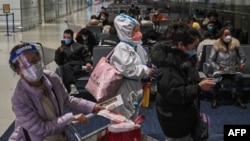Several countries have said they will monitor the wastewater from flights arriving from China in response to an explosion of COVID-19 cases across the nation.
While the measure will not prevent the spread of the virus, it will give a glimpse into the scale of China's outbreak and whether new variants are emerging there.
How does it work?
The process involves examining the mixture of urine and feces from the toilets of flights that have arrived from China.
The wastewater can then be analyzed to discover roughly what percentage of the passengers have COVID, as well as the variants.
Local authorities collect the wastewater directly after the aircraft lands and send it to laboratories for testing.
Once the virus has been detected, its genome is sequenced to find out if it is a known subvariant.
Wastewater also can be collected from an entire airport, but this makes it impossible to determine which country the samples originated from.
Which countries?
Belgium, Canada, Austria and Australia are among the countries that have indicated they will test the wastewater of planes coming from China.
The European Union is expected to follow suit after most of the national health ministry officials on Tuesday recommended stepping-up wastewater monitoring.
The United States is also considering the measure, according to U.S. media reports.
Why?
Infections have soared in China since last month, when it started lifting strict zero-COVID measures in place since the start of the pandemic.
Several countries including the U.S. have said they require passengers arriving from China to provide negative COVID tests, sparking Beijing's ire.
Unlike such tests, monitoring wastewater would not bar people currently positive for COVID from entering a country.
However, "these samples offer a window into what is currently happening in China," said Antoine Flahault, director of the Institute of Global Health at the University of Geneva.
This could be particularly important with "doubts about the transparency and diligence of the official health information coming from the Chinese government," he told AFP.
The World Health Organization on Wednesday criticized Beijing's "very narrow" definition of COVID deaths and said China's official statistics "under-represent" hospital admissions and deaths in the country.
Less invasive
Monitoring wastewater could help fill in the missing data, Flahault said.
"Knowing that 30 to 50 percent of passengers from China are currently infected is useful, in the absence of reliable figures," he said.
It also allows countries to find out about possible new variants that could change the trajectory of the pandemic, as omicron did in late 2021.
Health experts have warned that the explosion of cases among China's 1.4 billion population could provide a fertile breeding ground for new strains.
Monitoring wastewater is much easier to carry out, and far less invasive, than testing passengers as they arrive at the airport.
Limitations
While examining wastewater "works remarkably well," it does not give an "exhaustive view" of the infections or variants onboard the plane, French virologist Vincent Marechal told AFP.
One limitation is that wastewater can only monitor those passengers who used the toilet during the flight.
It also takes days to collect, test, sequence and analyze the findings, which cannot be broken down by individual passengers.
This offers few avenues to quickly act on the results.
"Once you have the information, what can you do with it? Call back all the people who were on the plane?" Marechal asked. "It is interesting but is already too late for the measures that one can take."








